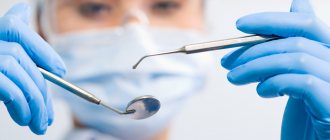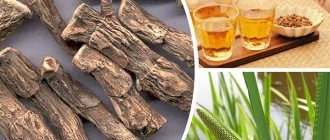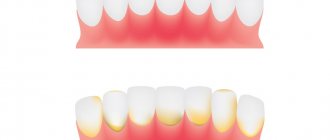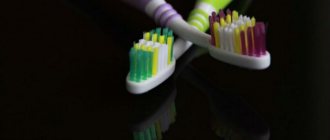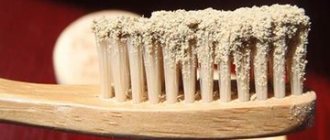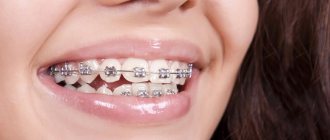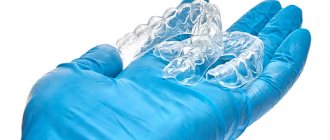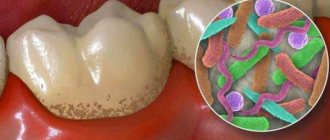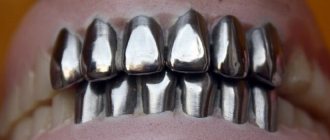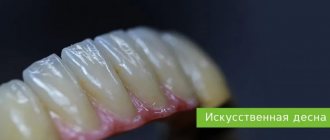When an adult’s tooth hurts and becomes loose, it is always pathological in nature and is not considered normal. Why do teeth become loose in adulthood?
There is a whole list of reasons:
- Gum pathologies. Inflammatory and infectious diseases of the oral cavity - periodontitis, gingivitis. They make the gums weak and cause bleeding. The tooth root weakens and the teeth begin to hurt and move.
- Hidden chronic diseases. Sometimes a tooth hurts and becomes loose due to hidden chronic pathologies. For example, with inflammatory processes in the joints, including jaw joints, arthrosis, endocrine disorders, weakening of the cardiovascular system, calcium deficiency, tumors.
- Carrying a child. Hormonal imbalance and a decrease in the amount of calcium in the blood can lead to loosening of molars and their loss.
- Mechanical damage. Impacts, scratches and other damage to the jaws can cause loosening. Especially if inflammation has developed in the area of damage.
You can strengthen loose molars by regularly using preventive measures:
- Periodically clean from stones and plaque.
- Quit smoking.
- Eat fully and correctly.
- Clean your teeth with strengthening agents.
- Do not start inflammation in the oral cavity.
- Take calcium supplements.
In addition, you need to undergo a dental examination at least once a year.
If the tooth is a little loose
If your teeth have just begun to loosen, then you need to urgently take preventive measures. If you don’t know why your teeth have become loose, then it’s better to see a doctor for control.
What to do after being examined by a doctor:
- Brush your teeth and rinse your mouth twice a day.
- Correct the bite if there is deformation.
- Monitor the condition of your gums.
- Eat right, including vegetables, fruits and foods rich in fluoride and calcium in your diet.
These methods will help strengthen your teeth and prevent further loosening.
Diagnostic features
A correct diagnosis will help determine how to treat the disease. To do this, it is important to assess the degree of tissue damage. The following methods are used in the diagnostic process:
- visual examination with measurement of the depth of periodontal pockets and assessment of the functional state of the periodontium;
- taking anamnesis;
- X-ray examination.
Based on the results, the doctor will draw up a periodontogram, which gives a complete picture of the condition of the periodontium. It is a special table in which X-ray data, measurements of the depth of periodontal pockets, tooth mobility, level of attached gums and depth of recession are entered.
Part of the molar is movable
Teeth can become loose and fall out in parts. When half a tooth is loose, the dentist takes an x-ray to determine whether the root is affected or only the outer part of the crown is damaged. If the root is not damaged and the base is preserved, then it can be saved. The upper part of the crown is removed and a pin is installed in its place. Then extension is carried out. If the pin cannot be placed, then a polymer filling is placed, and a crown is placed on it. When a tooth becomes very loose and the root is crushed, it is removed and an artificial crown is placed in its place.
Treatment with folk remedies
Many sources write about all kinds of folk remedies for the treatment of periodontal disease. Some techniques (rinsing with tincture of oak bark, walnut leaves, calendula or chamomile) can indeed be recommended by a doctor, but only as an additional element of complex treatment. It is important to understand that periodontal disease is considered a disease that is almost impossible to get rid of completely, so do not self-medicate under any circumstances - there is a high chance of only aggravating the situation. In severe stages of periodontal disease, tooth loss occurs, and the only option is their removal and removable dentures.
What to do after a blow
Dental bruises are closed injuries received after strong mechanical impact. (hitting a hard object). In this case, the teeth remain in place, do not move, but may begin to move. The front ones are especially vulnerable. If your front tooth becomes loose after an impact, you should immediately consult a doctor so that you can save it. X-rays and electroodontodiagnosis are prescribed. The latest diagnostic method makes it possible to see the beginning of the development of tissue necrosis and remove dying particles to prevent inflammation.
As a rule, medications are not used for tooth bruises. Swelling of the gums is relieved with cold compresses, and the patient must be on a liquid diet for some time to keep the molar at maximum rest. Sometimes, dentists practice grinding the cutting edge of the tooth and the cusps of the opposite tooth on the lower jaw, which the patient touches when chewing food.
Useful products containing micro- and macroelements
Thanks to a well-formulated diet, teeth receive from food the elements necessary for aesthetics and health. To try to balance your diet yourself, it is important to understand which elements are most suitable for maintaining the basic functions of a person's teeth.
It is not at all necessary to eat only high-quality food purchased in expensive stores. It is enough to properly balance the diet so that the dental tissues receive everything they need.
The daily diet requires the presence of necessary vitamins, micro- and macroelements, without which dental health will be undermined. Experts advise following the daily norm, which will allow you to keep your teeth healthy and seek help from dentists less often.
Calcium
An element that everyone knows about. It is considered the main component of dental tissue. Lack of it in the diet leads to rapid tooth decay. The absence or insufficient amount of calcium in food leads to the destruction of enamel, a decrease in the resistance of teeth to various influences, and leads to the formation of caries and gum pathologies.
To get the necessary element, it is recommended to consume the following products:
- legumes (beans, beans);
- eggs;
- hard cheeses;
- almond;
- sesame;
- raisin;
- black bread;
- dairy products (cottage cheese, milk, cheese curd);
- White cabbage.
For adults, the daily norm is 800 g per day. Children and pregnant women need larger dosages. Their daily norm exceeds 1200–1800 g of calcium.
Phosphorus
This microelement is a connecting link with which it is possible to correctly distribute calcium particles obtained from food. Strengthens enamel and hard tooth tissues. Natural phosphorus is found in large quantities in potatoes, legumes, cheese, poultry, beef, fish, buckwheat, rice and eggs.
The daily intake of phosphorus for an adult is 1500–1800 g.
Fluorine
Foods that are good for teeth should include sea fish, pork, buckwheat, walnuts and poultry. They contain a large amount of natural fluoride, which protects teeth from negative external influences.
Lack of fluoride leads to the formation of caries and periodontal disease.
Every day a person should receive at least 7–10 g of fluoride from healthy foods. If this is not ensured, pathogenic microorganisms that enter with food, air and drink destroy our teeth.
Iron
An important element in the body's hematopoietic system is iron. It is obtained from peas, mushrooms, spinach, apples, walnuts, beef liver or seaweed. It ensures normal blood supply to the gums and nearby tissues around the tooth. A lack of iron quickly leads to gum damage - periodontal disease.
The daily dose of the element ranges from 10 to 18 g. In the absence of the element entering the body, pathologies develop in a short time and quickly affect the gums.
| Microelement | Products containing |
| Calcium | Milk, cottage cheese, eggshells, beans, beans, sesame seeds, almonds, white cabbage, black bread. |
| Phosphorus | Potatoes, legumes, cheese, poultry, eggs, beef, fish, buckwheat, rice. |
| Fluorine | Pork, walnuts, poultry, sea fish. |
| Iron | Peas, egg yolk, spinach, apples, walnuts, beef liver, mushrooms, seaweed. |
Knowing which foods contain useful microelements, you can create a competent diet to get everything you need for healthy teeth.
If the root one is unsteady
Often a healthy tooth begins to hurt sharply and become loose. Permanent teeth can also become loose, even if they are molars. You don’t need to endure it, but go to the dentist. The doctor prescribes disinfectants: rinsing with chlorhexidine and furatsilin solution, gel applications.
If the gums are inflamed, then anti-inflammatory and regenerating drugs are prescribed. (“Trental”, “Olazol”, etc.). Physiotherapy also helps stop the process. For example, vacuum massage, darsonval, ultrasound procedures.
After stopping the inflammatory processes in the oral cavity, the dentist strengthens the teeth in the correct position and applies a temporary splint. If a wisdom tooth is loose and hurts, it is most often removed since it does not play a special role in the chewing process.
Side effects of toothpastes with antiseptics -
We urge you to be careful when using toothpastes that contain the antiseptic chlorhexidine (especially if its content is 0.1% or higher). Providing an antimicrobial effect on certain types of pathogenic bacteria, chlorhexidine leads to a total change in the ratio of different types of microorganisms in relation to each other. Scientific studies (source) found that with long-term use of toothpastes with chlorhexidine, the number of bacteria in the oral cavity increased, which were characterized by more active production of lactic acid.
Accordingly, this led to an increase in the content of lactic acid in the oral fluid (saliva), and a shift in pH to the acidic side. At the same time, this led to a decrease in the buffer capacity of saliva, which reduces the ability of saliva to neutralize acids secreted by cariogenic bacteria. This is important because the acidic pH of oral fluid promotes demineralization of tooth enamel (leaching of calcium) and, accordingly, increases the risk of developing caries.
Important for patients with cardiovascular pathology –
Unfortunately, these are not all the side effects of chlorhexidine. The fact is that this antiseptic disrupts the ability of oral bacteria to convert nitrates (contained in foods) into nitrites. This bacterial activity is called “nitrate-reducing,” and it is one of the mechanisms that allows our body to maintain normal blood pressure. Nitrites produced by bacteria enter the blood, helping to lower blood pressure.
Accordingly, a decrease in the production of nitrites by oral bacteria will lead to an increase in blood pressure, which is especially dangerous for people with existing cardiovascular pathology. These data are confirmed by scientific research - “The increase in plasma nitrite after a dietary nitrate load is markedly attenuated by an antibacterial mouthwash. Nitric Oxide" (2008), authors – Mirco Govoni, Emmelie Å. Jansson, Eddie Weitzberg, Jon O. Lundberg. And if you wish (via the link above), you can familiarize yourself with this study using a browser translator.
Front
The upper front teeth are very mobile, so they often begin to wobble. To find out the reason for this, a comprehensive examination is carried out, including a panoramic photograph of the oral cavity. What to do if your front molar is loose?
After determining the causes, a complete sanitation of the oral cavity is required to destroy infectious pathogens. If periodontal disease is detected, the specialist performs a special massage on the gums, darsonval procedures. If signs of periodontitis are detected, then be sure to remove stones and plaque, and polish the teeth with an ultrasonic beam. The entire surface of the tooth, including the neck, is polished with a brush using medical varnish containing fluoride.
Difficult deposits are removed with curettes, which pass under the gums, pulling out deposits. Open curettage is also performed, where the gum is cut and then stitched back together. Additionally, medications are prescribed that relieve inflammation with an antiseptic effect.
If the upper front teeth of an adult are seriously damaged or separated, a splint is placed on the upper jaw. A small hole is drilled in the molar into which fiberglass is placed. After which everything is covered with any composite substance that reflects light rays. Thus, during the movement of the front jaw, the molars do not move apart.
In the event of a mechanical injury, when part of the crown is broken and the tooth root is damaged, all fragments are removed and artificial crowns are installed in place of the natural tooth. The sooner a patient contacts a dentist with a problem, the higher the success of treatment. In complex cases, surgery may be required.
Clinical researches
Repeated clinical studies have proven that regular use of preventive toothpaste ASEPTA ACTIVE for a month can reduce bleeding gums by 60%, improve the overall condition of the oral cavity by 44% and reduce inflammation by 33%.
Sources:
- Clinical and laboratory assessment of the influence of domestic therapeutic and prophylactic toothpaste based on plant extracts on the condition of the oral cavity in patients with simple marginal gingivitis. Doctor of Medical Sciences, Professor Elovikova T.M.1, Candidate of Chemical Sciences, Associate Professor Ermishina E.Yu. 2, Doctor of Technical Sciences Associate Professor Belokonova N.A. 2 Department of Therapeutic Dentistry USMU1, Department of General Chemistry USMU2
- Clinical studies of antisensitive toothpaste “Asepta Sensitive” (A.A. Leontyev, O.V. Kalinina, S.B. Ulitovsky) A.A. LEONTIEV, dentist O.V. KALININA, dentist S.B. ULITOVSKY, Doctor of Medical Sciences, Prof. Department of Therapeutic Dentistry, St. Petersburg State Medical University named after. acad. I.P. Pavlova
- Report on determining/confirming the preventive properties of toothpaste “ASEPTA PLUS” GENTLE WHITENING” Author: doctor-researcher A.A. Leontyev, head Department of Preventive Dentistry, Doctor of Medical Sciences, Professor S.B. Ulitovsky First St. Petersburg State Medical University named after. acad. I.P. Pavlova, Department of Preventive Dentistry
- Report on the determination/confirmation of the preventive properties of personal oral hygiene products “ASEPTA PLUS” Remineralization doctor-researcher A.A. Leontyev, head Department of Preventive Dentistry, Doctor of Medical Sciences, Professor S.B. Ulitovsky First St. Petersburg State Medical University named after. acad. I.P. Pavlova, Department of Preventive Dentistry
What to do if your teeth are loose and your gums hurt
When gums bleed and become inflamed, teeth can also become loose and even fall out. One of the factors that provokes this condition is acute or chronic gingivitis. The inflammatory process provokes a light plaque on the teeth consisting of microbial pathogens or the formation of tartar on the teeth if you do not take good care of the oral cavity. If gingivitis is not treated, the germs travel deeper into the tissue. Periodontitis develops when pus forms on the gums, the necks of the teeth are exposed, and constant pain appears.
With periodontitis, the inflammatory process occurs in the tissues, from the base of the tooth root. At the same time, gumboil appears and the gums become very swollen and painful. Sometimes, due to chronic infection, cysts form on the gums; they do not appear immediately. In severe cases, a granuloma forms on the gums, in which bacteria attack the gums and roots of the teeth. In this case, the person experiences severe itching and high fever.
Also, gums can hurt after tooth extraction, installation of implants, braces, appliances, or improper dental treatment.
If your teeth are loose in your gums, you should not:
- Press your finger on the gum
- Heat with compresses, sand, warm rinses
- Open an abscess at home
- Taking too many painkillers
First of all, you need to relieve pain with pills or injections. But under no circumstances should you exceed the dosage. Paracetamol, analgin, ketanol and other similar products are suitable. You can also use gels with an analgesic and cooling effect.
You can rinse your mouth with Chlorhexidine and Miramistin. This needs to be done in the morning at lunch and in the evening to get results.
Why is there a need to strengthen enamel?
Caries is one of the most common problems that dentists have to deal with. It is because of its frequent occurrence that many people are forced to look for ways to strengthen their teeth. The disease is caused by:
- genetic predisposition to an abnormal process;
- disruptions in the functioning of the endocrine system;
- severe pathologies of the stomach and intestines;
- untimely removal of soft plaque and hard stone;
- non-compliance with dental cleaning techniques;
- refusal to eliminate non-carious enamel lesions;
- pathological abrasion;
- incorrect bite, due to which it is impossible to properly clean individual interdental areas;
- poor diet, habit of eating a lot of sour and sweet foods;
- alcohol abuse, tobacco addiction;
- habit of chewing foreign objects.
Often the enamel is greatly weakened due to hormonal changes. This is why many expectant mothers become patients in dental clinics.
